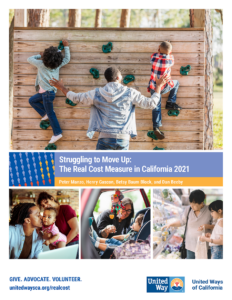Search
THE 2021 REAL COST MEASURE REPORT
July 27, 2021
The 2021 Real Cost Measure Report again reveals the true high cost of living in the Bay Area and in California.
United Ways of California, in partnership with California’s 29 United Ways, just released Struggling to Move Up: The Real Cost Measure in California 2021, a new study that reveals what it takes to make ends meet in California. Unlike the official poverty measure which primarily considers the cost of food, the Real Cost Measure factors the costs of housing, childcare, health care, transportation and other basic needs for a more accurate measure of self-sufficiency among working households. Overall, we find 32% of California households, 3.5 million, struggle to meet basic needs.
The study, Struggling to Move Up: The Real Cost Measure in California 2021, finds that the share of families that struggle financially is 250 percent higher in California than what is factored in the federal government’s measure. It amounts to 3.5 million families who are unable to meet basic needs — a situation affecting Hispanic/Latinx and Black households at much higher rates than other communities. The federal government uses an outdated formula for calculating poverty — one that fails to consider how much rent, transportation, healthcare, and other basic needs cost in California.
Some of the primary findings from The Real Cost Measure in California 2021 include:
– Nearly one in three California households—over 3.5 million families (32%)—do not earn sufficient income to meet basic needs
– Households of all races struggle, but the challenges are greatest for Hispanic/Latinx and Black Families: Over 1.7 million Hispanic/Latinx households (51% of all families) are estimated to not earn enough to get by, compared to over 1.06 million white households (20%); 481,618 Asian American households (28%); 259,516 Black households (41%); and 13,592 Native American/Alaska Native households (39%).
– Struggling Households Work: Of the estimated 3.5 million households in California that fall below the Real Cost Measure, 97% have at least one working adult.

“This study shows that many more California working families struggle to meet living costs than official estimates and identifies significant gaps between what it costs for families and their children to live with dignity and what they actually earn,” said Peter Manzo, President & CEO of United Ways of California. “This new perspective should be the yardstick by which we set our priorities, and the study is a wake-up call to local community partners, civic leaders, the business sector, and elected officials that so much more needs to be done to help families not just survive but actually thrive.”
“The results of this study could not make a stronger case for the importance of United Way of the Bay Area’s (UWBA) mission,” said Kevin Zwick, Chief Executive Officer, UWBA. “The cost-of-living challenges in our region have been present for decades and are only becoming worse as income disparities increase. We will continue to meet the immediate and intermediate needs of distressed families while building on our legacy of program development, relationship building, and advocacy needed to create the long-term systemic changes that allow more of our neighbors to thrive across the Bay Area.”
The study is based on the U.S. Census Bureau’s Community Survey data from 2014 through 2019. The study’s website provides figures for each of California’s 58 counties, down to the city and neighborhood level, and offers interactive maps and a feature that calculates how much a family in any region needs to make ends meet.
RELATED RESOURCES
The Real Cost Measure in California 2021 – San Francisco Bay Area (PDF)
Real Cost Measure in California 2021 Resources
The Real Cost Measure Report 2021 Bay Area Interactive Map



